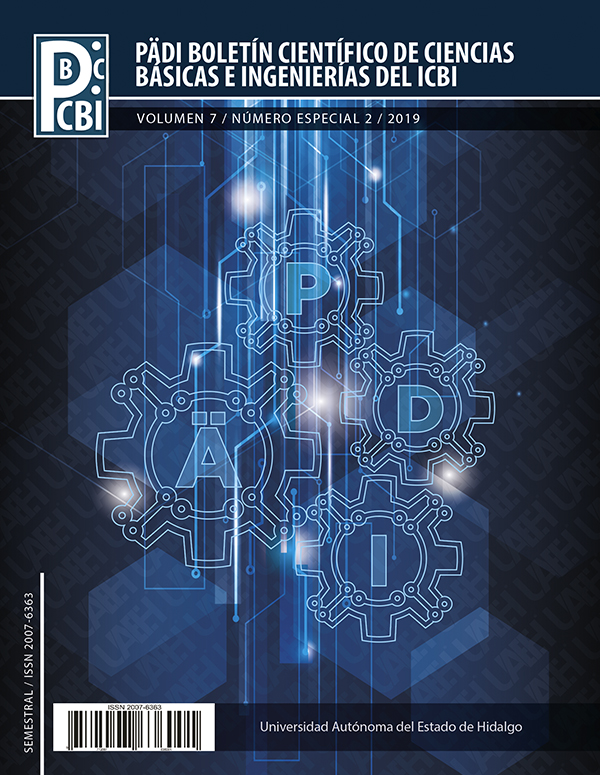Efecto del Tamaño de Grano Austenítico en el Comportamiento Mecánico para los Aceros AISI 1045 y 4140 Mediante Experimentación y Modelado
DOI:
https://doi.org/10.29057/icbi.v7iEspecial-2.4919Palabras clave:
Simulación, Tratamiento térmico, Tamaño de grano austenítico, Propiedades mecánicasResumen
Los aceros de medio C son ampliamente utilizados en la fabricación de piezas y componentes mecánicos tales como engranajes, ejes, pernos, acoplamientos, husillos, ruedas dentadas, bielas y cigüeñales, debido a su buena resistencia mecánica, tenacidad y resistencia al desgaste. Muchas investigaciones para este tipo de aceros se han enfocado en estudiar el comportamiento al desgaste, deformación y análisis de propiedades mecánicas a temperaturas elevadas. Sin embargo, existen pocos estudios que se han enfocado en evaluar su comportamiento mecánico en función del tamaño de grano austenítico (TGA). En esta investigación, se presentan los resultados experimentales y mediante modelado numérico, del efecto del TGA antes del temple en dos aceros de medio C, AISI 1045 y 4140, con la finalidad de determinar las condiciones óptimas de procesamiento para obtener las propiedades mecánicas deseadas. El tamaño de grano fue evaluando entre 5 y 110 µm. Se utilizaron técnicas experimentales para determinar la microestructura, resistencia a la cedencia, resistencia a la tensión, la dureza y pruebas de dilatometría de temple para determinar su deformación. Los resultados simulados fueron obtenidos mediante el software JMatPro. De estos resultados se pueden mencionar que el TGA juega un papel importante en la evolución de las propiedades mecánicas para los aceros estudiados. Cuando el TGA fue superior a 15 y 45 µm para los aceros AISI 4140 y 1045 respectivamente, las propiedades mecánicas estuvieron en rangos más elevados. Los resultados mediante JMatPro estuvieron muy cercanos a los obtenidos experimentalmente, validando la simulación numérica en la predicción de las propiedades mecánicas estudiadas.
Descargas
Información de Publicación
Perfiles de revisores N/D
Declaraciones del autor
Indexado en
- Sociedad académica
- N/D
Citas
Bhadeshia, H.K.D.H., 2008. Mathematical Models in Materials Science, Materials Science and Technology, 24: 128-135.
Białobrzeska B, Konat Ł and Jasiński R., 2017. The influence of austenite grain size on the mechanical properties of low-alloy steel with boron. Metals, 7: 26-45.
Celada-Casero C, Sietsma J and Santofimia M.J., 2019. The rol of the austenite grain size in the martensitic transformation in low carbon steels. Materials and Design 167: 107625-107634.
Frihat M., 2015. Effect of heat treatment parameters on the mechanical and microstructure properties of low-alloy steel. Journal of Surface engineering Materials and Advanced Technology, 4: 214-227.
Guo Z, Saunders N, Miodownik P and Schillé J. P., 2009. Modelling Phase Transformation and Material Properties Critical to the Prediction of Distortion During the Heat Treatment of Steels. International Journal Microstructure and Materials Properties, 4: 197-195.
Lee S.J, Park J.S and Lee Y.K., 2008. Effect of austenite grain size on the transformation kinetics of upper and lower bainite in a low-alloy steel. Scripta Materialia 59: 87-90.
López-García R.D, García-Pastor F. A, Castro-Roman M.J, Alfaro-López E and Acosta-González F., 2016. Effect of immersion routes on the quenching distortion of a long steel component using a finite element model. Transaction of the Indian Institute of Metals 69(9): 1645-1656.
Meysami A.H, Ghasemzadeh R, Seyedein S.H and Aboutalebi M.R., 2010. An investigation on the microstructure and mechanical properties of direct-quenched and tempered AISI 4140 steel. Materials and Design 31: 1570-1575.
Moleejane C. M, Sanusi K.O, Ayodele O.L and Oliver G.J., 2014. Microstructural features and mechanical behaviour of unalloyed medium carbon steel (EN8 Steel) after subsequent heat treatment," Proceedings of the World Congress of Engineering and Computer Science, vol. 2: 1-6.
Prawoto Y, Jasmawati N and Sumeru K., 2012. Effect of prior austenite grain size on the morphology and mechanical properties of martensite in medium carbon steel. Journal of Materials Science and Technology 25(5): 461-466.
Ruffing C, Ivanisenko Y and Kerscher E., 2016. A comparison of the fatigue and fracture behavior of high strength ultrafine grained medium carbon steel SAE 1045 with high strength bearing steel SAE 52100. 21st European Conference on Fracture, ECF21, 20-24 June 2016, Catania, Italy. Procedia Structural Integrity 2: 3240-3247.
Saunders N, Guo Z, Li X, Miodownik A.P and Schillé J., 2003. Using JMatPro to model materials properties and behavior. Journal of the Minerals, Metals and Materials Society, 55: 60-65.
Taghizadeh S, Safarian A, Jalali S and Salimiasl A., 2013. Developing a model for hardness prediction in water-quenched and tempered AISI 1045 steel through an artificial neural network. Materials and Design 51: 530-535.
Trzaska J, Jagiello A and Dobrzanski L.A., 2009. The calculation of CCT diagrams for engineering steel. Achives of Materials Science and Engineering, 39: 13-20.
Ulutan M, Osman N, Celik, H. G and Umit E. 2010. Effect of different surface treatment methods on the friction and wear behavior of AISI 4140 steel. Journal of Materials Science & Technology 26(3): 251-257.
Yaakoubi M, Kchaou M and Dammak F., 2013. Simulation of the thermomechanical and metallurgical behavior of steels by using ABAQUS software. Computational Materials Science, 68: 297-306.
Yang H.S and Bhadeshia H.K.D.H., 2009. Austenite grain size the martensite-start temperature. Scripta Materialia 6: 493-495.




















